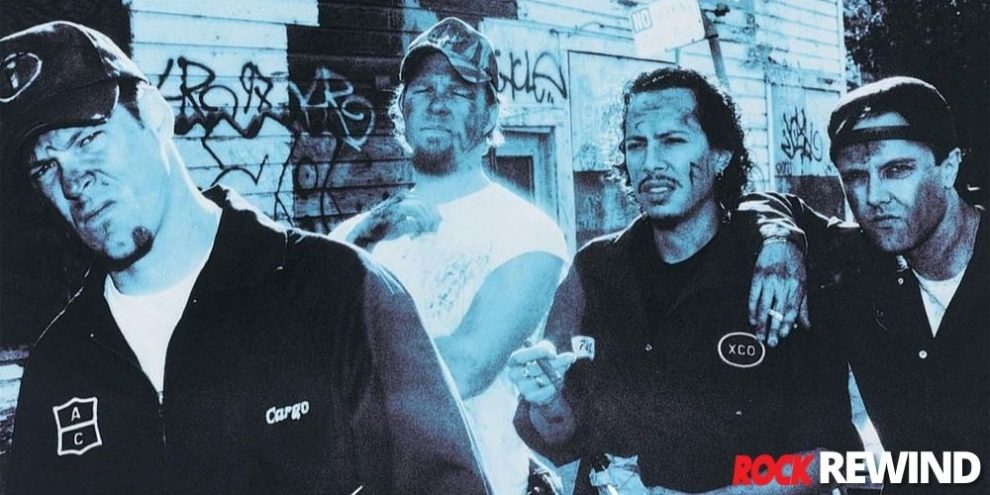Rock Rewind: Metallica’s Rise to Heavy Metal Titans

From raw thrash beginnings in the underground metal scene to becoming stadium-packing legends, Metallica’s story is one of rebellion, reinvention, and resilience. Born in the fiery crucible of early '80s metal, their music has blown up speakers, defied expectations, and inspired generations.
Let’s crank the volume and rewind to where it all began…
Snag Our Newsletter
From LA Garages to Bay Area Blitz
In 1981, drummer Lars Ulrich placed an ad in the local newspaper looking for other metal artist to jam with.
The ad read, “Drummer looking for other metal musicians to jam with, Tygers of Pan Tang, Diamond Head and Iron Maiden.”
James Hetfield answered and the two began playing together, influenced by the speed and aggression of the New Wave of British Heavy Metal (NWOBHM). The duo set out to create something faster, louder, and more aggressive than anything on American airwaves.
Soon Lars and Hetfield were joined by guitarist Dave Mustaine and the trio formed Metallica.
Their first original song was “Hit the Lights,” which was recorded for Metal Massacre, a compilation album produced by Metal Blade Records.
On March 14, 1942, Metallica’s first live performance took place at Radio City in Anaheim California. By this time, Ron McGovney, who had previously played with Hetfield in their band Leather Charm, joined Metallica.
Metallica began recording demos – most famously No Life 'Til Leather – which spread like wildfire among tape-trading metalheads.
McGovney Is Replaced By Burton
In late 1982, Ulrich and Hetfield were at Whiskey a Go Go in West Hollywood to watch a show. The pair were blown away with the band’s bassist, Cliff Burton, and asked him to join Metallica. They had grown unhappy with McGovney. In Unbound, an unofficial biography of the band, Hetfield explained, “Ron didn't contribute anything, he just followed."
Mustaine expanded, saying, "A bass player is supposed to follow the drummer and Ron would follow the guitarist. Ron could never follow what we did and copy us. Then we came up here and played with Cliff who just blew the doors off of anyone we've ever played with. He's the new [Iron Maiden Bassist] Steve Harris of metal."
Burton initially declined, but by the end of the year, he said he would accept the offer, so long as the band moved to El Cerrito.
Metallica’s first live performance with the new lineup was in March 1983.
Mustaine Is Kicked Out
In May 1983, Metallica was ready to record their debut album. But before they started recording, tensions flared.
Mustaine was ousted due to substance abuse and violent behaviour. He was replaced by Kirk Hammett of Exodus.
Mustaine went on to form the band Megadeth but never hid his dislike for Hammett. In an Ask Men interview, he explains, “ … I hated Kirk so much and I was pissed off that he became so popular off of my efforts …” And when talking with Chart Attack he said, “I really don't care about Kirk [Hammett] — he stole my job, but at least I got to bang his girlfriend before he took my job — how do I taste, Kirk?”
In 1983, Metallica dropped their debut album Kill ’Em All — a sledgehammer of speed and aggression that laid the groundwork for thrash metal. Songs like “Seek & Destroy” and “Whiplash” were raw, fast, and unapologetically loud. The album aslo included a reworked version of “Mechanix” titled “The Four Horsemen.”
Following the release of Metallica’s Debut album, Kill ‘Em All, Mustaine included “Mechanix,” on Megadeth’s first album. When asked why he included it, he said, “That was just to straighten Metallica up. They’re saying I’m a drunk and I can’t play. It’s real funny how Kirk Hammett ripped off every lead break I’d played on that No Life ‘Til Leather tape and got voted number one guitarist in your magazine. It’s also funny how they play their second album and they’ve still got a reel-to-reel of all my riffs and stuff. God knows when they’re gonna stop writing the songs that I originally wrote.”
Growth, Tragedy, and a New Era
With the release of Kill ‘Em All, the band had officially arrived — but this was just the beginning.
They followed up quickly with 1984’s Ride the Lightning, showing musical growth with complex arrangements and deeper lyrics. Tracks like “Fade to Black” hinted at the emotional depth to come, while “Creeping Death” and “For Whom the Bell Tolls” solidified their reputation as riff-writing machines.
In 1986, Metallica released what many still consider their masterpiece: Master of Puppets. It was a flawless blend of brutality and precision — an album packed with iconic tracks like the title song, “Battery,” and “Welcome Home (Sanitarium).” The band went on to tour with Ozzy Osbourne before embarking on their Damage, Inc. Tour.
But tragedy struck just months into their European tour. On September 27, 1986, bassist Cliff Burton died in a bus crash in Sweden. He was just 24.
Looking back on the accident, Hetfield remembers, “I saw the bus lying right on him. I saw his legs sticking out. I freaked. The bus driver, I recall, was trying to yank the blanket out from under him to use for other people. I just went, "Don't fucking do that!" I already wanted to kill the [bus driver]. I don't know if he was drunk or if he hit some ice. All I knew was, he was driving and Cliff wasn't alive anymore.”
The loss devastated the band. But rather than folding, they pushed forward with Burton’s family’s blessing. Over 40 people auditioned to be Metallica’s bassist. The band ended up hiring one of Hammett’s childhood friends, Jason Newsted, as their new bassist.
While fans didn’t immediately embrace Newsted, the band soldiered on, determined to honour Cliff’s legacy.
...And Justice for All — and One Big Black Album
In 1988, Metallica released …And Justice for All, a dense, political, and complex album known for its intricate songwriting — and for almost completely burying the bass in the mix. Becoming the band’s first album in the top 10 of Billboard 200 at number 6, the album gave us “Blackened,” “Harvester of Sorrow,” and “One,” their first song to crack MTV with a stark, haunting music video.
After …And Justice For All came Metallica’s game-changer: The Black Album (1991).
Produced by Bob Rock, the self-titled Metallica album was a thunderous pivot toward a more mainstream, polished sound. It featured now-iconic anthems like “Enter Sandman,” “Nothing Else Matters,” “The Unforgiven,” and “Sad But True.” The album shot them into superstardom, selling over 30 million copies worldwide and dominating radio.
Metallica was no longer just a metal band — they were a global phenomenon.
Load, Re-Load, and the Napster Controversy
With success came experimentation.
The mid-to-late ’90s saw Metallica trade in their thrash roots for bluesy, alternative-influenced sounds with Load (1996) and Re-Load (1997). Gone were the long hair and leather — replaced by eyeliner, short cuts, and more radio-friendly singles like “Until It Sleeps” and “The Memory Remains.”
Some fans loved the new direction. Others cried betrayal.
Then came the infamous Napster era. In 2000, Metallica discovered that their “I Disappear” demo, meant for the Mission: Impossible II soundtrack, was getting radio airplay. Following the leak, they found out that the song was on Napster. In response, Metallica sued the peer-to-peer file-sharing service, and became the face of the anti-piracy movement.
While their stance on artists’ rights was valid, the backlash was severe. Fans viewed the band as out of touch, and their reputation took a hit.
St. Anger and the Band’s Breaking Point
In January 2001, Newsted left the band. In a statement, the bassist explained, “Due to private and personal reasons and the physical damage I have done to myself over the years while playing the music that I love, I must step away from the band.
"This is the most difficult decision of my life, made in the best interest of my family, myself and the continued growth of Metallica. I extend my love, thanks and best wishes to my brothers: James, Lars and Kirk and the rest of the Metallica family, friends and fans who have made these years so unforgettable."
Soon after, in July 2001, Hetfield went into rehab putting plans for their next album on hold.
While this did create some doubt about the band’s future, Metallica returned to the studio in April 2002 to record St. Anger without a permanent bass player. Instead, Bob Rock played bass for both the upcoming album and live shows during that time.
Their recording process was filmed by Joe Berlinger and Bruce Sinofsky — which became the 2004 documentary Some Kind of Monster.
With no guitar solos, a controversial drum sound, and lyrics that felt like therapy sessions, St. Anger polarized fans. But it also marked a turning point — a necessary purging before the next chapter.
Eventually, former Suicidal Tendencies bassist Robert Trujillo joined the band, bringing renewed energy and a grounding presence that remains to this day.
A Return to Form and Metallica’s Modern Era
2008’s Death Magnetic was a triumphant return to thrash. Produced by Rick Rubin, it combined the raw intensity of their early work with modern polish. Songs like “The Day That Never Comes” and “All Nightmare Long” showed Metallica still had plenty of gas in the tank.
They followed it with the experimental Lulu in 2011 (a divisive collaboration with Lou Reed) and Hardwired… to Self-Destruct in 2016 — a double album that once again proved Metallica could evolve without forgetting where they came from.
Metallica Today: Still Unstoppable
In 2023, Metallica unleashed 72 Seasons, an introspective concept album exploring the first 18 years of life (72 seasons). With tracks like “Lux Æterna,” the record was fast, heavy, and full of bite — a celebration of the band’s endurance and raw emotion.
And their live show? Still unmatched.
With cutting-edge stage setups, multi-night “No Repeat Weekends,” and Lars’ boundless energy behind the kit, Metallica continues to headline the biggest festivals and sell out stadiums worldwide.
Metallica Discography
Since 1981, Metallica has put out:
1 cover album - Garage Inc. (1998)
13 live albums - Live Shit: Binge & Purge (1993), S&M (1999), Orgullo, Pasión, y Gloria: Tres Noches en la Ciudad de México (2009), Six Feet Down Under (2010), The Big Four: Live from Sofia, Bulgaria (2010), Six Feet Down Under II (2010), Live at Grimey’s (2010), Liberté, Égalité, Fraternité, Metallica! (2016), Helping Hands...Live & Acoustic at the Masonic (2019), Live in Chile (1993 – 2017) (2020), Live in Argentina (1993 – 2017) (2020), Live in Brazil (1993 – 2017) (2020) and S&M2 (2020)
1 soundtrack album - Metallica: Through the Never (2013)
1 tribute album - The Metallica Blacklist (2021)
3 box sets - The Good, The Bad & The Live (1990), Limited-Edition Vinyl Box Set (2004) and The Metallica Collection (2009)
1 collaboration album - Lulu (2011)
They’ve also released 11 studio albums …
1. Kill 'Em All (1983)
Before Metallica became the biggest metal band on the planet, they kicked the doors down with Kill ’Em All.
Dropping in 1983, this debut album didn’t exactly explode on the charts, but it did blow minds in the underground metal scene. It was loud, fast, raw, and completely unapologetic.
Originally, Metallica wanted to call the album Metal Up Your Ass – complete with a toilet and a dagger on the cover – but the label wasn’t having it.
The band was p*ssed but they knew they had to change the name. Cliff Burton, never one to sugarcoat anything, reportedly responded with, “You know what? Fuck those fuckers, man, those fucking record outlet people. Just, we should just kill ‘em all!” And that’s how we got the name.
Songs like “Seek & Destroy” and “Whiplash” showed off the band’s thrash roots, mixing punk energy with blistering guitar work that sounded like nothing else at the time. This was also the world’s first real taste of Cliff Burton’s talent on bass, bringing in a bit of musicality to balance all that chaos.
Kill ’Em All didn’t make Metallica superstars overnight, but it laid the groundwork for everything that followed—and it proved they weren’t just another garage band. They were the future of metal, whether the world knew it yet or not.
2. Ride the Lightning (1984)
If Kill ’Em All was Metallica kicking down the door, Ride the Lightning was them saying, “Oh, by the way—we can actually play.”
Released in 1984, this album saw the band level up in a big way, both musically and lyrically. Suddenly, it wasn’t just about speed and aggression. We got deeper themes like death, fear, war, even the electric chair (shoutout to the title track). Pretty heavy stuff for a bunch of dudes barely out of their teens.
The album was the first with Hammett and proved Metallica wasn’t a one-trick thrash pony. While Mustaine co-wrote two songs, he was no longer with the band when recording started.
From the galloping chaos of “Fight Fire with Fire” to the storytelling of “Creeping Death,” they showed range and ambition. And while it didn’t top the charts right away, Ride the Lightning built serious momentum—and it's now considered a metal masterpiece.
Ride the Lightning reached number 100 on the Billboard 200 and has since been recognized as one of the most influential metal albums, earning a spot on Rolling Stone's list of "100 Greatest Metal Albums of All Time.”
3. Master of Puppets (1986)
Released in 1986, Master of Puppets is often called their magnum opus and for good reason. It’s heavier, faster, and darker than anything they’d done before, with riffs so iconic they basically redefined thrash metal forever. The title track alone is a masterpiece of intricate riffs and crushing grooves that still blows minds decades later.
Master of Puppets was the last album to feature bassist Cliff Burton, who tragically died in a bus accident during the band’s European tour. His influence is all over this record, from the epic instrumental “Orion” to his thunderous bass tone that helped give Metallica their signature sound.
Despite its massive impact, Master of Puppets didn’t hit the Billboard Top 10 when it first dropped. It took years and a whole lot of relentless touring before it got the mainstream respect it deserved.
Master of Puppets was the first Metallica album to be certified Gold, and eventually went Platinum, proving that true greatness takes time to sink in.
4. ...And Justice for All (1988)
…And Justice for All dropped in 1988 and took Metallica’s sound into a darker, more complex place. The songs got longer, the riffs more intricate, and the lyrics hit harder, tackling themes like corruption, war, and injustice with zero sugar coating.
It was a bold step up in songwriting that split some fans at first but ultimately cemented Metallica’s reputation as serious metal masterminds. It was also their first album to break into the Billboard Top 10, hitting #6. This proved the band was no longer just an underground thrash act but a mainstream force.
Metallica also scored their first-ever Grammy nomination for Best Hard Rock/Metal Performance with …And Justice for All. They were the clear favorites after performing “One” live at the ceremony … but in a shocking twist, the award went to Jethro Tull, a band known more for prog rock than metal.
The moment became infamous, with Metallica waiting backstage, stunned, and Jethro Tull’s manager reportedly advising them to skip the show, thinking Metallica would win.
It’s still talked about as one of the biggest Grammy upsets ever.
Musically, the album is famous for its almost invisible bass lines, thanks to production choices that buried Cliff Burton’s replacement, Jason Newsted, in the mix. But that didn’t stop tracks like “One” from becoming anthems, blending heavy riffs with haunting melodies and one of Metallica’s most powerful music videos.
Despite the controversy, …And Justice for All stands as a pivotal moment in Metallica’s evolution — a bold, intricate album that pushed the band into new territory and helped define the sound of late-80s metal.
5. Metallica (1991)
When Metallica (often just called The Black Album) landed in 1991, it marked a major shift for the band.
The sound was cleaner, more polished, and way more accessible, packed with some of their biggest hits like “Enter Sandman” and “Nothing Else Matters.”
But behind the scenes, not everyone was feeling the same emotional vibes as Hetfield’s heartfelt ballads.
While James was singing about romantic longing, Hammett, Ulrich, and Newsted were going through some tough personal times. Between …And Justice for All and The Black Album, all three went through divorces. Hammett and Ulrich had both married in ’87 but split after the grueling Damaged Justice tour, and Newsted’s marriage in ’89 was annulled after just a few months.
Despite all the personal chaos, or maybe because of it, the band delivered their most commercially successful album yet, selling millions and turning Metallica into global rock icons. It was the album that took them from thrash legends to mainstream heavyweights, opening their music to a whole new generation.
6. Load (1996)
With Load, Metallica stepped away from their thrash metal roots and embraced a more hard rock and blues-influenced sound. This album revealed a band experimenting with groove, melody, and darker, more personal lyrics.
This shift was influenced by the band's exposure to a diverse range of artists during their hiatus, including Kyuss, Alice in Chains, Soundgarden, Primus, ZZ Top, Pantera, Corrosion of Conformity, Ted Nugent, Aerosmith, Oasis, Alanis Morissette, and Garth Brooks.
It shocked some fans with its slicker production and different aesthetic – think shorter hair, cowboy hats, and even a controversial album cover featuring a mix of cow blood and human semen.
Despite the mixed reaction, Load went multi-platinum, propelled by hits like “Until It Sleeps” and “Hero of the Day.”
Notably, Load was Metallica's longest studio album at 78:59 minutes. The band also adopted a new E♭ tuning for all tracks, a departure from their previous use of standard tuning.
Upon release, Load debuted at number one on the Billboard 200 chart, selling 680,000 copies in its first week, making it the band's biggest opening week at the time. The album was certified 5× Platinum by the RIAA for shipping five million copies in the United States. However, the shift in musical direction polarized fans, with some expressing disappointment over the band's departure from their thrash metal origins.
7. Reload (1997)
Released just a year after Load, Metallica's Reload continued the band's exploration into hard rock and blues influences, solidifying their departure from thrash metal roots.
Like Load, this album was recorded at The Plant in Sausalito, California, and produced by Bob Rock, James Hetfield, and Lars Ulrich. The cover art, titled "Piss and Blood XXVI," was created by artist Andres Serrano using a mixture of bovine blood and his own urine, a continuation of the controversial artwork from Load.
Reload debuted at number one on the Billboard 200, selling 436,000 copies in its first week, and was certified 3× Platinum by the RIAA. The album featured notable tracks like "The Memory Remains," which included guest vocals by Marianne Faithfull, and "The Unforgiven II," a sequel to the band's 1991 hit.
Despite its commercial success, Reload received mixed reviews from critics. Some praised its musical diversity and maturity, while others felt it lacked the energy of earlier works. Nevertheless, the album showcased Metallica's willingness to evolve and experiment with new sounds and themes.
8. St. Anger (2003)
Metallica’s St. Anger marked one of the most turbulent periods in the band’s history, both musically and personally. After battling addiction, lineup changes, and internal struggles, the band returned with a raw, aggressive sound that was a sharp departure from their polished '90s records.
The album was produced by Bob Rock, who also played bass during the recording sessions after Jason Newsted’s departure.
The production of St. Anger was famously controversial – the drums have a very distinctive, almost metallic “clanging” sound, as Lars Ulrich intentionally avoided the use of cymbals, aiming for an aggressive, stripped-down feel. This was a bold choice that divided fans and critics alike.
Lyrically, the album is deeply personal, reflecting the band’s internal battles and frustrations, with themes of anger, addiction, and redemption front and center. The title track “St. Anger” won a Grammy for Best Metal Performance in 2004, the band’s first Grammy win after several previous nominations.
While St. Anger debuted at number one on the Billboard 200, it polarized listeners, with many longtime fans criticizing the production and the absence of guitar solos. Despite the mixed reaction, it remains an honest and intense snapshot of Metallica during a raw, transitional phase.
9. Death Magnetic (2008)
Death Magnetic marked Metallica’s powerful return to their thrash metal roots after the raw experimentation of St. Anger.
Produced by Rick Rubin, the album was praised for its tight musicianship, complex arrangements, and a clear revival of the band’s classic sound full of shredding guitar solos, intricate riffs, and dynamic songwriting.
This album was also significant for reintroducing long-time fans to the technical prowess of James Hetfield, Kirk Hammett, Lars Ulrich, and new bassist Robert Trujillo, who had joined the band in 2003.
The songwriting displayed a blend of aggression and melody, with themes exploring mortality, addiction, and personal reflection.
Death Magnetic was both a critical and commercial success, debuting at number one on the Billboard 200 and earning Grammy nominations, including Best Rock Album. The album’s lead singles like “The Day That Never Comes” and “Cyanide” showcased Metallica’s ability to evolve while honoring their thrash legacy.
Fans and critics alike welcomed Death Magnetic as a revitalization of the band’s sound and spirit, reaffirming Metallica’s place as metal legends well into the 21st century.
10. Hardwired... to Self-Destruct (2016)
Hardwired... to Self-Destruct arrived eight years after Death Magnetic, delivering a double album that’s both a nod to Metallica’s aggressive thrash roots and a showcase of their matured songwriting. The record bursts with high-energy tracks like the explosive title song “Hardwired” and fan favorites “Moth Into Flame” and “Atlas, Rise!”.
Produced by Greg Fidelman alongside the band, this album blends ferocious riffs, intricate rhythms, and raw vocals, reflecting the band’s ongoing evolution while reconnecting with the fierce intensity that made them legends. It explores themes ranging from societal critique to personal struggle, tapping into a darker, introspective mood.
Commercially, Hardwired... to Self-Destruct debuted at number one in multiple countries, including the U.S. where it sold over 250,000 copies in its first week — proving Metallica’s enduring appeal to both old fans and a new generation.
Critics praised the album for striking a balance between nostalgia and innovation, cementing Metallica’s status as one of the most resilient and influential forces in heavy metal.
11. 72 Seasons (2023)
Metallica’s 72 Seasons marks their return after a seven-year gap, delivering a powerful and reflective album that digs deep into themes of personal growth, trauma, and self-discovery. The title refers to the first 18 years of life (72 seasons) when formative experiences shape who we become.
Musically, the album blends the band’s signature heavy riffs with more dynamic songwriting and melodic exploration, showing a band both rooted in their thrash metal legacy and unafraid to evolve. Tracks like “Lux Æterna” and “If Darkness Had a Son” showcase aggressive energy, while others reveal a nuanced emotional depth.
72 Seasons was met with critical acclaim, applauded for its tight musicianship and emotional honesty, and it debuted strongly on international charts. The album captures Metallica’s continued ability to push their sound forward while reflecting on life’s complexities, resonating with longtime fans and newcomers alike.
The Legacy of Metallica
Over four decades in, Metallica isn’t just a band — they’re a force. With countless accolades, Hall of Fame induction, and millions of albums sold, they’ve left a permanent mark on rock and metal history.
But beyond the records, the tours, and the transformations, Metallica’s real legacy lies in their uncompromising spirit. Through tragedy, reinvention, and controversy, they’ve never stopped moving forward.
And as long as there’s electricity to plug in an amp, you can bet Metallica will still be riding the lightning.
RELATED: Find out the story behind more legendary bands with Rock Rewind ...
Snag Our Newsletter
Hit that button like you’re pressing play on your favourite track. get exclusive content, stories, and news.







